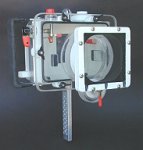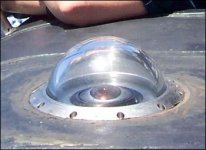Hello everyone-I wandered in here while looking for information about cast acrylic, maybe some of you can give me some of your opinions.
While you guys try to keep water in, I try to keep water out. Here's my website, I've attached a small photo below as well. We make these housings for filmakers and photographers, you may have seen some these guy's work on TV, or in surfing or other watersports movies and magazines.
Anyway, I used to make these housings out of Lucite L, but it's almost impossible to find it now. If I can find it, a full sheet costs about $250.USD. Now I've got to decide what I'm going to use instead of the Lucite. Most commonly available are Plexiglas G and CyroGP(AcryliteGP). After checking the technical specs, they look pretty similar. I use 1/4" for most of the work, including routing the edge of the plastic, drilling, tapping and cutting(mostly with a sabre saw). In front of the lens is 1/8" cast acrylic, tubing is cast acrylic. Glue using Weld-On 4.
Since many of you have used these plastic sheets, which of these two brands would you prefer? The machining is very precise so it must be easily machined. Out of the two, which one has the better optical quality? After all, it's going to be made into camera gear. Any other cast acrylic sheet you think I should consider?
Any advice or opinions would be greatly appreciated. Thanks in advance-Ron B
While you guys try to keep water in, I try to keep water out. Here's my website, I've attached a small photo below as well. We make these housings for filmakers and photographers, you may have seen some these guy's work on TV, or in surfing or other watersports movies and magazines.
Anyway, I used to make these housings out of Lucite L, but it's almost impossible to find it now. If I can find it, a full sheet costs about $250.USD. Now I've got to decide what I'm going to use instead of the Lucite. Most commonly available are Plexiglas G and CyroGP(AcryliteGP). After checking the technical specs, they look pretty similar. I use 1/4" for most of the work, including routing the edge of the plastic, drilling, tapping and cutting(mostly with a sabre saw). In front of the lens is 1/8" cast acrylic, tubing is cast acrylic. Glue using Weld-On 4.
Since many of you have used these plastic sheets, which of these two brands would you prefer? The machining is very precise so it must be easily machined. Out of the two, which one has the better optical quality? After all, it's going to be made into camera gear. Any other cast acrylic sheet you think I should consider?
Any advice or opinions would be greatly appreciated. Thanks in advance-Ron B







